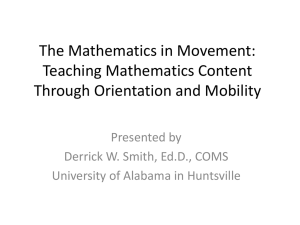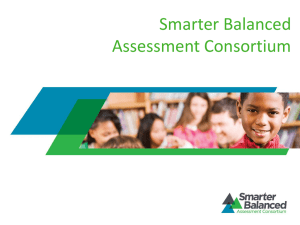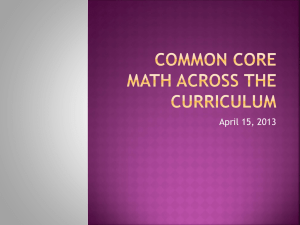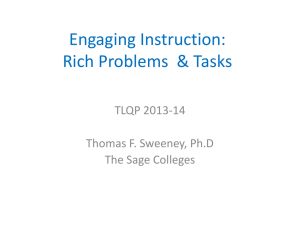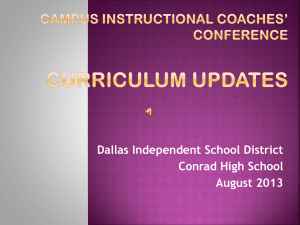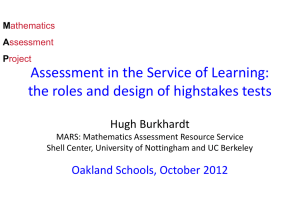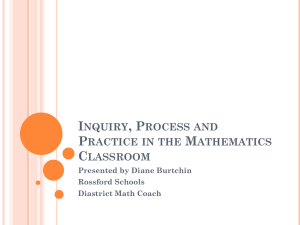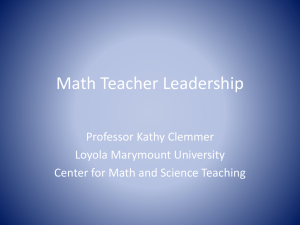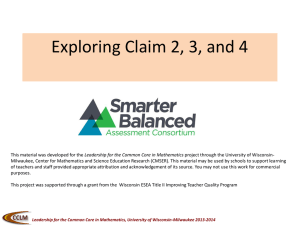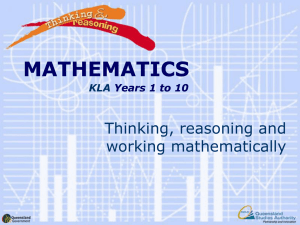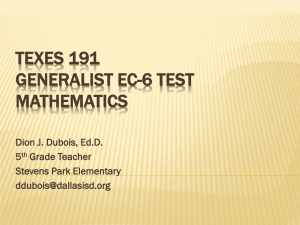Powerpoint
advertisement
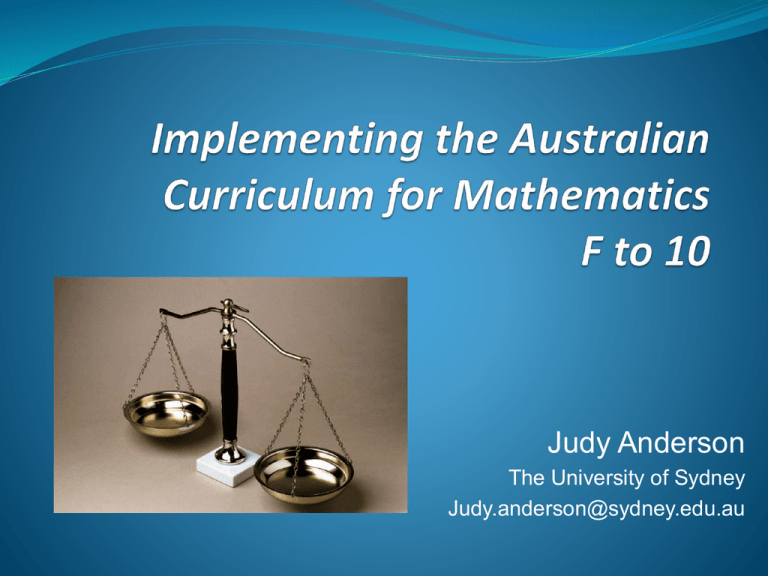
Judy Anderson The University of Sydney Judy.anderson@sydney.edu.au Key messages … 1. Balance is important 2. Evaluate the types of questions and tasks used during mathematics lessons 3. Assessment, assessment, assessment!!! 4. Alignment between curriculum, teaching and assessment Mathematics teaching should include opportunities for (Cockcroft, 1982): exposition by the teacher; discussion between teacher and pupils and between pupils themselves; appropriate practical work; consolidation and practice of fundamental skills and routines; problem solving, including the application of mathematics to everyday situations; and investigational work. Understanding Students build a robust knowledge of adaptable and transferable mathematical concepts. They make connections between related concepts and progressively apply the familiar to develop new ideas. Fluency Students develop skills in choosing appropriate procedures, carrying out procedures flexibly, accurately, efficiently and appropriately, and recalling factual knowledge and concepts readily. Which tasks would support these proficiencies? Examine the types of questions and tasks you use during mathematics lessons. Gould, 2006 ✔ Because three is a larger number ✖ than 2 Because four is a larger number ✖ than three Because six is a larger number ✖ than 3 Because 5 & 6 are larger numbers ✔ than 2 & 3 Because 12 & 13 are larger ✔ numbers than 9 & 10 Problem solving Students develop the ability to make choices, interpret, formulate, model and investigate problem situations, and communicate solutions effectively. Reasoning Students develop an increasingly sophisticated capacity for logical thought and actions, such as analysing, proving, evaluating, explaining, inferring, justifying, and generalising. Which tasks would support these proficiencies? Examine the types of questions and tasks you use during mathematics lessons. Bloom’s Taxonomy 1. Understand 2. Remember 3. Apply 4. Analyse Higher order thinking 5. Evaluate Problem solving 6. Create Reasoning Cognitive process What learners need to do Action verbs Remember Retrieve relevant information from long-term memory Recognise, recall, define, describe, identify, list, match, reproduce, select, state Understand Construct meaning from information and concepts Paraphrase, interpret, give egs, classify, summarise, infer, compare, discuss, explain, rewrite Apply Carry out a procedure or use a technique in a given situation. Change, demonstrate, predict, relate, show how, solve, determine Analyse Separate information into parts and determine how the parts relate to one another. Analyse, compare, contrast, organise, distinguish, examine, illustrate, point out, relate, explain, differentiate, organise, attribute Evaluate Make judgements based on criteria and/or standards. Comment on, check, criticise, judge, critique, discriminate, justify, interpret, support Create Put elements together to form a coherent whole, or recognise elements into a new pattern Combine, design, plan, rearrange, reconstruct, rewrite, generate, produce Thinkers Bills et al. (2004) Give an example of … (another and another) Open-ended Explain or justify Similarities and differences Always, sometimes or never true Odd-One-Out Generalise Hard and easy Approaches to teaching problem solving … The approach … Teaching for problem solving knowledge, skills and understanding (the mathematics) Teaching about problem solving heuristics and behaviours (the strategies and processes) Teaching through problem solving posing questions and investigations as key to learning new mathematics (beginning a unit of work with a problem the students cannot do yet) The outcome … Approaches to teaching problem solving … The approach … The outcome … Teaching for problem solving knowledge, skills and understanding (the mathematics) Problems at the end of the chapter! Teaching about problem solving heuristics and behaviours (the strategies and processes) Teaching through problem solving posing questions and investigations as key to learning new mathematics (beginning a unit of work with a problem the students cannot do yet) Approaches to teaching problem solving … The approach … Teaching for problem solving knowledge, skills and understanding The outcome … Problems at the end of the chapter! Teaching about problem solving Problems used to heuristics and behaviours (the strategies ‘practise’ strategies and processes) and checklists Teaching through problem solving posing questions and investigations as key to learning new mathematics (beginning a unit of work with a problem the students cannot do yet) Approaches to teaching problem solving … The approach … Teaching for problem solving knowledge, skills and understanding The outcome … Problems at the end of the chapter! Teaching about problem solving Problems used to heuristics and behaviours (the strategies ‘practise’ strategies and processes) and checklists Teaching through problem solving posing questions and investigations as Some success but key to learning new mathematics limited (beginning a unit of work with a problem implementation the students cannot do yet) Successful problem solving requires Deep mathematical knowledge Personal attributes eg confidence, persistence, organisation General reasoning abilities Skills and Attributes Heuristic strategies Abilities to work with others effectively Communication skills Helpful beliefs eg orientation to ask questions Stacey, 2005 Which tasks or problems? Types of problems??? Open-ended Rich tasks Real-world problem Challenge Investigation Inquiry Problem-based Reflective inquiry Which tasks or problems? Content specific questions requiring a range of levels of thinking Area and Perimeter in Year 5/6 Which shape has the largest perimeter? Please explain your thinking. Design a new shape with 12 squares which has the longest possible perimeter. Deep mathematical knowledge General reasoning abilities Communication skills Heuristic strategies Which card is better value? Please explain your thinking. Deep mathematical knowledge General reasoning abilities Communication skills Heuristic strategies Number and Algebra Number and Algebra Deep mathematical knowledge General reasoning abilities Communication skills Helpful beliefs eg orientation to ask questions Abilities to work with others effectively 1. Make up an equation where the answer is x = 2 2. Make up an equation where the answer is x = 3 3. Make up an equation where …. Another idea: Change one number in the equation 4 x – 3 = 9, so that the answer is x = 2. Number and Algebra Explain the difference between particular pairs of algebraic expressions, such as x 2 and 2x Compare similarities and differences between sets of linear relationships, eg. y 3x, y 3x 2, y 3x 2 Number and Algebra: Fractions Deep mathematical knowledge Explain why Explain why 1 8 is less than 1 4 2 1 3 3 4 7 Informal and Formal Proof General reasoning abilities Communication skills Abilities to work with others effectively Constructive alignment (Biggs, 2004) Curriculum Instruction Assessment Planning for Implementation (including Problem Solving and Reasoning) • Identify the topic (mathematical concepts) • Examine curriculum content statements • Use data to inform decisions on emphasis • Select, then sequence, appropriate tasks/activities • Identify the mathematical actions (proficiencies) in which you want students to engage • Design assessment for ALL proficiencies Favourite Sources MCTP (Maths 300 through www.curriculum.edu.au) Bills, C., Bills, L., Watson, A., & Mason, J. (2004). Thinkers. Derby, UK: ATM. Downton, A., Knight, R., Clarke, D., & Lewis, G. (2006). Mathematics assessment for learning: Rich tasks and work samples. Fitzroy, Vic.: ACU National. Lovitt, C., & Lowe, I. (1993). Chance and data. Melbourne: Curriculum Corporation. Sullivan, P., & Lilburn, P. (2000). Open-ended maths activities. Melbourne, Vic: Oxford. Swan, P. (2002). Maths investigations. Sydney: RIC Publications. Resources: MCTP (Maths 300) – Curriculum Corporation website http://www.curriculum.edu.au ABS – http://www.abs.gov.au NCTM – http://www.nctm.org NRICH website – http://nrich.maths.org.uk/primary Others??? Key messages … 1. Balance is important 2. Evaluate the types of questions and tasks used during mathematics lessons 3. Assessment, assessment, assessment!!! 4. Alignment between curriculum, teaching and assessment

